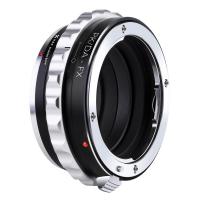What Are Microscopes Used For ?
Microscopes are used for magnifying and observing objects that are too small to be seen with the naked eye. They are widely used in various scientific fields, including biology, medicine, chemistry, and materials science. Microscopes allow scientists to study the structure, composition, and behavior of microscopic organisms, cells, tissues, and particles. They are essential tools for conducting research, diagnosing diseases, analyzing samples, and exploring the microscopic world. By providing detailed and enlarged images, microscopes enable scientists to gain a deeper understanding of the intricate details and processes that occur at the microscopic level.
1、 Magnification and Observation of Small Objects
Microscopes are scientific instruments that are used for the magnification and observation of small objects. They have been instrumental in advancing our understanding of the microscopic world and have revolutionized various fields of science, including biology, medicine, chemistry, and materials science.
The primary purpose of microscopes is to magnify objects that are too small to be seen with the naked eye. By using lenses or other optical systems, microscopes can enlarge the image of an object, allowing scientists to observe and study its intricate details. This ability to magnify objects has been crucial in discovering and understanding the structure and function of cells, microorganisms, and other tiny structures.
Microscopes have played a vital role in the field of medicine, enabling doctors and researchers to diagnose diseases, study tissues and cells, and develop new treatments. They have also been instrumental in the field of materials science, allowing scientists to analyze the composition and structure of materials at the atomic and molecular level.
In recent years, there have been advancements in microscopy techniques that have further expanded the capabilities of microscopes. For example, confocal microscopy allows for the imaging of three-dimensional structures with high resolution, while electron microscopy uses a beam of electrons to achieve even higher magnification and resolution.
Furthermore, the development of fluorescence microscopy has enabled scientists to label specific molecules or structures with fluorescent markers, allowing for the visualization of dynamic processes within living cells. This technique has revolutionized the field of cell biology and has provided valuable insights into various cellular processes.
In conclusion, microscopes are essential tools for magnifying and observing small objects. They have been instrumental in advancing scientific knowledge and have contributed to numerous discoveries and breakthroughs. With ongoing advancements in microscopy techniques, microscopes continue to play a crucial role in scientific research and exploration.
2、 Study of Microorganisms and Cells
Microscopes are used for the study of microorganisms and cells. They allow scientists to observe and analyze these tiny structures that are not visible to the naked eye. By magnifying the image, microscopes enable researchers to study the intricate details of microorganisms and cells, leading to a better understanding of their structure, function, and behavior.
Microorganisms, such as bacteria, viruses, and fungi, play a crucial role in various fields, including medicine, agriculture, and environmental science. Microscopes help scientists identify and classify different types of microorganisms, study their growth patterns, and investigate their interactions with other organisms. This knowledge is essential for developing treatments for infectious diseases, improving agricultural practices, and understanding ecological processes.
Similarly, microscopes are indispensable tools for studying cells, which are the basic building blocks of all living organisms. They allow scientists to observe the different components of cells, such as the nucleus, mitochondria, and cell membrane, and understand how these structures function together to support life. Microscopes also enable researchers to study cell division, cell differentiation, and cellular processes like metabolism and protein synthesis.
In recent years, advancements in microscopy techniques have revolutionized the field. For example, the development of fluorescence microscopy has allowed scientists to label specific molecules within cells and track their movements in real-time. This has provided valuable insights into cellular processes and has contributed to breakthroughs in areas such as cancer research and neurobiology.
Furthermore, the advent of electron microscopy has allowed scientists to visualize structures at an even higher resolution, revealing intricate details of cellular components and organelles. This has led to a deeper understanding of cellular mechanisms and has opened up new avenues for research.
In conclusion, microscopes are essential tools for the study of microorganisms and cells. They enable scientists to observe and analyze these tiny structures, leading to a better understanding of their structure, function, and behavior. With advancements in microscopy techniques, our knowledge of microorganisms and cells continues to expand, contributing to advancements in various scientific fields.
3、 Examination of Tissues and Biological Samples
Microscopes are used for the examination of tissues and biological samples. They play a crucial role in various scientific fields, including biology, medicine, and research. By magnifying objects that are too small to be seen with the naked eye, microscopes enable scientists to study the intricate details of cells, tissues, and microorganisms.
In the field of medicine, microscopes are essential for diagnosing diseases and understanding their underlying causes. Pathologists use microscopes to examine tissue samples obtained from biopsies or surgeries, allowing them to identify abnormalities and determine the presence of cancerous cells. Microscopes also aid in the study of infectious diseases, as they enable scientists to observe and identify bacteria, viruses, and parasites.
In biology, microscopes are used to explore the structure and function of cells and tissues. They allow scientists to observe cellular processes, such as mitosis and meiosis, and study the interactions between different cell types. Microscopes are also used in genetics research to analyze chromosomes and study the inheritance of traits.
Furthermore, microscopes have evolved over time, with advancements such as electron microscopy and confocal microscopy. Electron microscopes use a beam of electrons instead of light, providing higher magnification and resolution. This allows scientists to visualize even smaller structures, such as individual molecules. Confocal microscopy, on the other hand, uses laser technology to create detailed three-dimensional images of biological samples, providing a clearer understanding of their structure and organization.
In recent years, microscopes have also been used in emerging fields such as nanotechnology and materials science. They are employed to study the properties and behavior of nanomaterials, helping researchers develop new materials with enhanced properties for various applications.
In conclusion, microscopes are invaluable tools for the examination of tissues and biological samples. They have revolutionized our understanding of the microscopic world and continue to contribute to advancements in various scientific disciplines.
4、 Analysis of Material Structures and Surface Features
Microscopes are used for the analysis of material structures and surface features. They are essential tools in various scientific fields, including biology, chemistry, physics, and materials science. Microscopes allow scientists to observe and study objects that are too small to be seen with the naked eye, enabling a deeper understanding of their composition, properties, and behavior.
In biology, microscopes are used to study cells, tissues, and microorganisms. They help in identifying and classifying different species, studying their anatomy, and investigating cellular processes. Microscopes also play a crucial role in medical research, allowing scientists to examine pathogens, study diseases, and develop new treatments.
In chemistry, microscopes are used to analyze the structure and composition of materials at the atomic and molecular level. They help in identifying and characterizing chemical compounds, studying their reactivity, and understanding their physical properties. Microscopes are particularly useful in fields such as nanotechnology, where the manipulation and observation of materials at the nanoscale are essential.
In physics, microscopes are used to investigate the fundamental properties of matter and explore phenomena at the atomic and subatomic level. They are used in fields such as quantum mechanics, solid-state physics, and materials science to study the behavior of particles, crystals, and materials under different conditions.
The latest point of view regarding the use of microscopes is the advancement in imaging techniques and technologies. With the development of high-resolution microscopy techniques, such as scanning electron microscopy (SEM), transmission electron microscopy (TEM), and atomic force microscopy (AFM), scientists can now observe and analyze materials with unprecedented detail and precision. These advancements have opened up new possibilities in fields such as nanoscience, where the manipulation and characterization of individual atoms and molecules are becoming increasingly important.
In conclusion, microscopes are indispensable tools for the analysis of material structures and surface features. They enable scientists to explore the microscopic world, unravel the mysteries of nature, and make significant advancements in various scientific disciplines. The continuous development of microscopy techniques promises even more exciting discoveries and applications in the future.



























There are no comments for this blog.